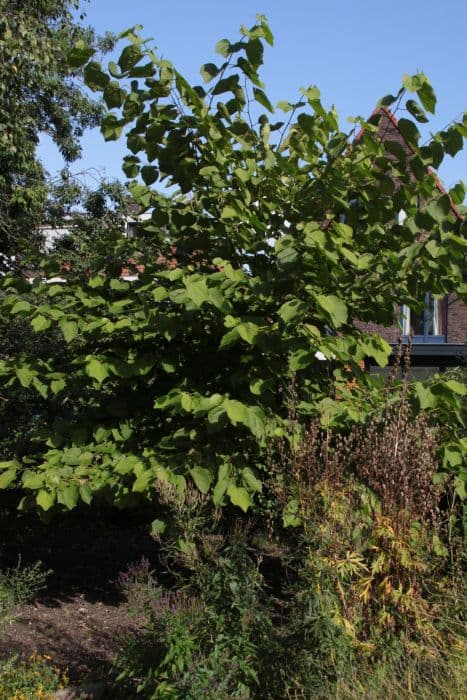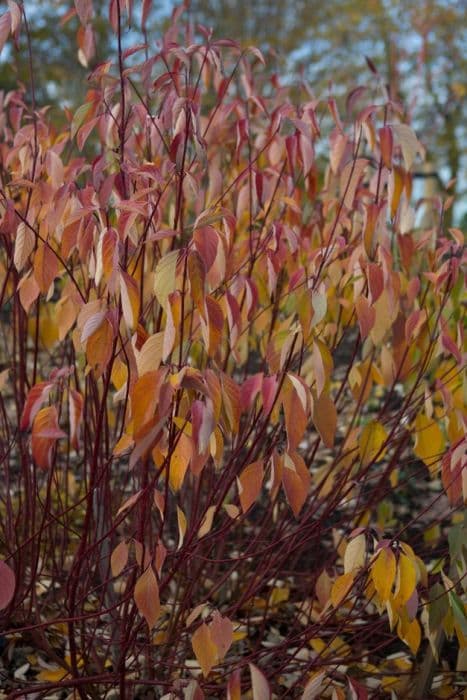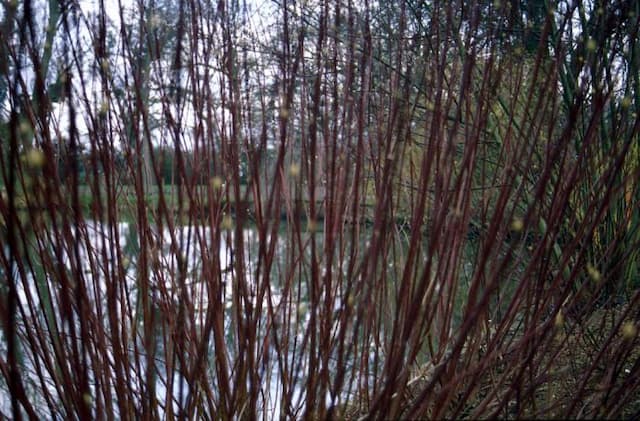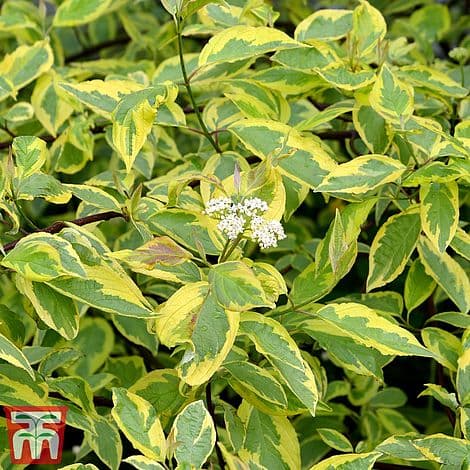Silky Dogwood Cornus amomum 'Blue Cloud'











ABOUT
The 'Blue Cloud' is a variety of silky dogwood, distinguished by its multiple stems and rounded, bushy shape. This cultivar is known for its striking ornamental features throughout the year. During spring, it boasts a lush display of dark green leaves, which serve as a backdrop to small, creamy white flowers. These flowers cluster together in flat-topped bunches and exude a subtle charm typical of many flowering shrubs. As summer unfolds, the 'Blue Cloud' transitions into a new phase of visual interest when it produces berries. The fruit starts out as a greenish hue but soon ripens to a deep, porcelain blue, providing a stark contrast against the foliage. During this time, the leaves begin to transform, offering a hint of the vibrant autumn display that is to come. The arrival of fall sees the silky dogwood at perhaps its most vibrant. The leaves change to a mixture of purples, reds, and oranges, creating a warm and spectacular display of autumnal color. This seasonal change also makes the blue of the berries even more pronounced as they persist on the branches. When winter sets in, the 'Blue Cloud' loses its leaves, revealing a rustic charm in its bare, reddish-brown stems. These stems stand out against the often bleak winter landscape, providing visual interest during the coldest months with their textured bark and strong, vertical lines. Overall, the 'Blue Cloud' silky dogwood is a dynamic plant that presents a year-round appeal with its changing colors, flowers, and berries.
About this plant
 Names
NamesFamily
Cornaceae
Synonyms
Silky Dogwood, Kinnikinnik, Red Willow, Blue Cloud Silky Dogwood
Common names
Swida amomum (Marshall) Small, Thelycrania amomum (Marshall) Pojark.
 Toxicity
ToxicityTo humans
The Silky Dogwood, though not commonly known as a toxic plant to humans, may still pose some health risks if ingested in large quantities. As with many plants, caution should be exercised as individual sensitivity to plants can vary. There are no well-documented cases of poisoning from the Silky Dogwood, suggesting that it is generally considered safe. However, it is always advisable to avoid eating parts of ornamental plants due to potential herbicides, pesticides, or other chemicals that may be present. If symptoms such as gastrointestinal discomfort, nausea, or allergic reactions were to occur after ingestion, it is important to seek medical advice.
To pets
The Silky Dogwood is not widely recognized as a toxic plant to pets such as dogs and cats. Yet, pet owners should still avoid allowing their pets to ingest plants that are not intended for consumption, as individual reactions can vary and some could experience mild gastrointestinal upset or an allergic reaction. If a pet does ingest Silky Dogwood and exhibits symptoms like vomiting, diarrhea, or unusual behavior, it is recommended to consult a veterinarian. Generally, the Silky Dogwood is not associated with severe toxicity in pets.
 Characteristics
CharacteristicsLife cycle
Perennials
Foliage type
Deciduous
Color of leaves
Green
Flower color
White
Height
6-8 feet (1.8-2.4 meters)
Spread
6-8 feet (1.8-2.4 meters)
Plant type
Shrub
Hardiness zones
5
Native area
North America
Benefits
 General Benefits
General Benefits- Attractive Foliage: The plant has beautiful bluish-green leaves that add aesthetic appeal to landscapes.
- Wildlife Habitat: Provides shelter and nesting sites for birds and other wildlife.
- Erosion Control: Its strong root system helps secure soil and prevent erosion, particularly along waterways.
- Seasonal Interest: Features eye-catching white to pale blue flowers in spring and colorful, blue to purple berries in summer end.
- Fall Color: Leaves turn a vibrant red or purple in the fall, offering seasonal color variation.
- Low Maintenance: Requires minimal care once established, making it suitable for low-maintenance landscaping.
- Tolerates Wet Soil: Can thrive in wetter areas where other plants might struggle, making it ideal for rain gardens or wetland buffers.
- Supports Pollinators: Flowers provide nectar and pollen for bees and other pollinators.
 Medical Properties
Medical Properties- This plant is not used for medical purposes
 Air-purifying Qualities
Air-purifying QualitiesThis plant is not specifically known for air purifying qualities.
 Other Uses
Other Uses- Crafting Dyes: Cornus amomum 'Blue Cloud', also known as silky dogwood, can provide blue and green dyes when its bark and leaves are processed.
- Natural Insecticide: The extracts from silky dogwood can prove to be a mild insect repellent for certain insect species.
- Photography: The fruit clumps of silky dogwood can be used as natural subjects for close-up photography or botanical illustration.
- Erosion Control: This plant's strong root system helps stabilize soil on slopes and riverbanks, preventing erosion.
- Wildlife Shelter: Its dense foliage makes silky dogwood a good habitat for small wildlife, providing shelter and nesting sites.
- Winter Interest: With its bright red stems, silky dogwood adds color to winter landscapes when most other plants are dormant.
- Water Filtering: These shrubs are often planted near water bodies to help filter runoff and improve water quality.
- Natural Fence: Silky dogwood can be planted in a tight row to create a natural barrier or living fence on property lines.
- Soil Amendment: After degradation, its leaves and branches can be used as mulch to add nutrients back into the soil.
- Art Supplies: The stems and branches of the silky dogwood can be used in basket weaving and other crafting activities.
Interesting Facts
 Feng Shui
Feng ShuiSilky dogwood is not used in Feng Shui practice.
 Zodiac Sign Compitability
Zodiac Sign CompitabilitySilky dogwood is not used in astrology practice.
 Plant Symbolism
Plant Symbolism- Resiliency: The 'Blue Cloud' variety of Silky Dogwood, which is a type of Cornus amomum, is known for its hardy nature, symbolizing one's ability to withstand difficult conditions.
- Transformation: Silky Dogwood shrubs go through a remarkable transformation with seasons, their leaves turning vibrant colors in fall, symbolizing change and adaptability.
- Protection: Historically, dogwoods have been associated with safety and shelter, likely because they are commonly found in the understory of forests, offering protection to smaller plants and animals.
- Renewal: In spring, Silky Dogwood's fresh blossoms represent rebirth and new beginnings, as the plant awakens from the winter dormancy.
 Water
WaterFor the Silky Dogwood (Cornus amomum 'Blue Cloud'), water the base of the plant thoroughly, avoiding overhead watering to prevent leaf diseases. During the first growing season, ensure consistent moisture by watering weekly or more often during dry spells, aiming for about 1 inch of water per week. Adjust frequency based on soil type and weather conditions, decreasing to every two to three weeks once the plant is established. In hotter climates or during extreme heat, increase watering but avoid waterlogging. Mature plants will require less frequent watering, generally every two to three weeks with about 1.5 gallons per session.
 Light
LightSilky Dogwood thrives in full sun to part shade. The best spot for the plant is an area that receives at least four hours of direct sunlight daily, but it can also tolerate partial shade. Avoid deep shade, as this will reduce the vigor and flowering of the plant.
 Temperature
TemperatureSilky Dogwood is hardy and can tolerate a wide range of temperatures. Ideally, it grows best when daytime temperatures are between 60°F and 75°F. The plant can survive in temperatures as low as -30°F and as high as 90°F, but extreme temperatures for prolonged periods might stress the Silky Dogwood.
 Pruning
PruningPrune Silky Dogwood to maintain its shape, remove dead or damaged branches, and promote a more abundant flowering. The ideal time for pruning is late winter or early spring before new growth starts. Prune every one to three years, depending on the growth rate and desired form. Cut just above a set of buds and remove no more than one-third of the plant to maintain its health.
 Cleaning
CleaningAs needed
 Soil
SoilThe Silky Dogwood 'Blue Cloud' prefers moist, well-draining soil enriched with organic matter, with a slightly acidic to neutral pH of 6.0 to 7.0. A mix containing peat, loamy soil, and perlite or sand would be ideal for this plant.
 Repotting
RepottingThe Silky Dogwood 'Blue Cloud' does not need frequent repotting and can often be left undisturbed for several years as it is normally grown as a landscape plant. It is generally repotted only when it outgrows its current location or needs soil replenishment.
 Humidity & Misting
Humidity & MistingSilky Dogwood 'Blue Cloud' is adaptable to a wide range of humidity levels, but it thrives best in moderate to high humidity, typical of its natural wetland habitats.
 Suitable locations
Suitable locationsIndoor
Provide bright light, and keep soil moist for Silky Dogwood.
Outdoor
Plant in partial sun, moist soil, and mulch around Silky Dogwood.
Hardiness zone
5-9 USDA
 Life cycle
Life cycleCornus amomum 'Blue Cloud', commonly known as the Silky Dogwood, begins its life cycle as a seed which germinates in moist, well-drained soil typically in early spring. The seedling emerges and grows into a young plant, developing a fibrous root system and initial shoots. As it matures, the Silky Dogwood enters a vegetative state, producing oval, blue-green leaves and sturdy stems; during this stage, the shrub increases in size and starts to form its characteristic shape. Following the vegetative phase, the plant reaches maturity and enters its reproductive stage, usually around mid to late spring, producing clusters of small, creamy white flowers that attract pollinators. By late summer, these flowers give way to clusters of blue berries, which are often consumed by birds, aiding in the dispersal of the seeds. The Silky Dogwood completes its life cycle with a period of dormancy in winter, when leaves drop, and then resumes growth in the following spring.
 Propogation
PropogationPropogation time
Late Winter-Early Spring
The Cornus amomum 'Blue Cloud', commonly known as Silky Dogwood, is typically propagated through softwood cuttings. This process generally takes place in the late spring or early summer when new growth is tender yet mature enough to handle cutting and rooting. A popular method involves taking cuttings of about 5 to 6 inches (12.7 to 15.24 cm) in length from new growth. The leaves on the lower half of the cutting are removed, and the cut end is dipped in a rooting hormone to encourage root development. The treated cutting is then inserted into a pot with a mixture of moistened perlite and peat, ensuring that the nodes where leaves were removed are below the surface. The pot is then placed in a location with indirect light and covered with a plastic bag to maintain humidity. In a few weeks, once the roots have taken hold, the new Silky Dogwood plant can be transferred to a more permanent location.









